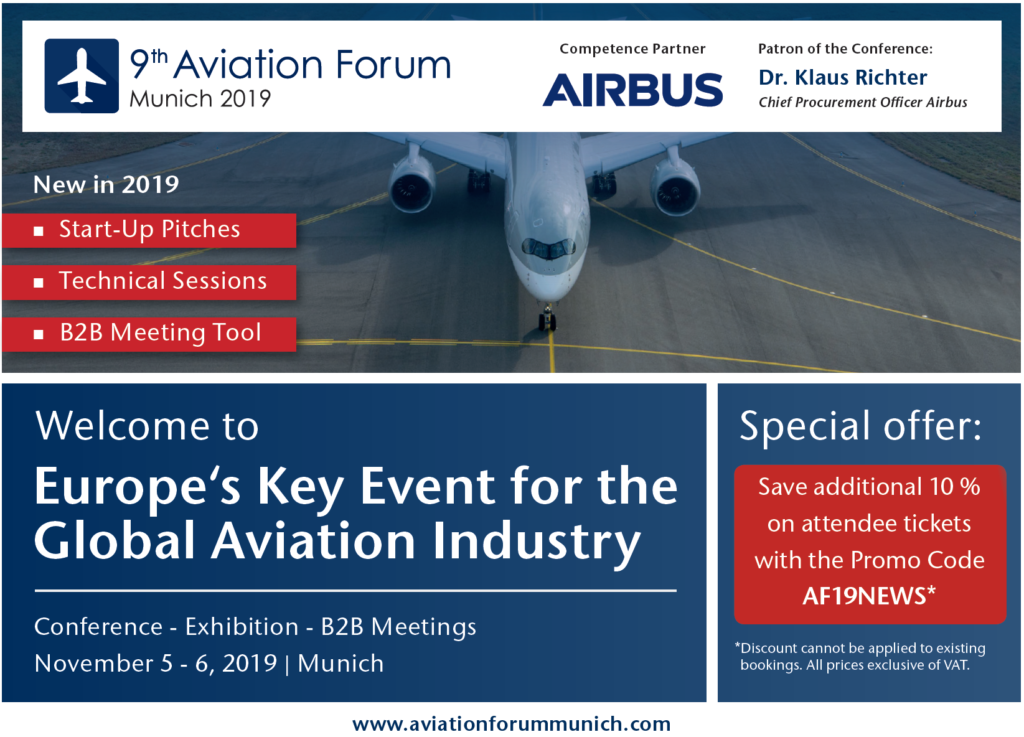Leeham News and Analysis
There's more to real news than a news release.
Aviation Forum Munich: Vertical integration on the way back
By Bjorn Fehrm
November 5, 2019, ©. Leeham News at Aviation Forum Munich: The Aviation Forum kicked off in Munich today, a yearly production and supply chain event started by the Hannover based Institute for Production Management nine years ago.
Today’s conference themes were How the OEMs benefit from Supplier Innovation, Additive Manufacturing trends and discussions around Outsourcing and Insourcing.
Insourcing for increased competitiveness
One of the interesting presentations was by the CEO of Latecoere, Yannick Assouad, who talked about Latcoere’s new Aerostructures Factory of type 4.0.
Latecoere is a French aircraft manufacturer created in Toulouse 50 years before Airbus. It’s today the world’s leading supplier of aircraft doors. If you have flown on an Airbus A320 or Boeing 787 you have passed Latecoere’s doors. It’s also active in airliner wiring systems and other aerostructures.
To support its door production it has created a new 4.0 factory in Toulouse which is producing complete finished parts in a fully automated process running 24/7.
The factory has cut the production time for key components for the doors from three months to three weeks. While doing so it has improved quality, cost and supply reliability to the door production.
The new factory is an example where changing a classical industrial setup from a network of suppliers, doing their part of the finished product, to a fully insourced setup where the input is base materials in one end and out comes finished parts on the other end, has been the key to success.
The example is not showcasing a reverse of the outsourcing trend of recent years. It shows the production strategy has to adapt to the job at hand. There is no single best way of going about the industrialization of products.
In this case, the door parts are typical machined metal parts of aluminum or titanium. They need a multitude of machining steps before they can be surface treated as finished parts. This lent itself to a fully insourced automated process chain.
By embracing factory 4.0 principles like:
- Start by building a digital twin of the factory in Dassault’s Delmia simulation tool and optimize product flow and operations before building the real factory
- Investing in connected and automated machines for all operations which keep track on their quality level of tools and jigs and report all information to the overall factory control layer
- Elimination of all transports inside and outside the factory
- RFID tracking of all materials, products and tools, meaning all can be tracked where they are in the factory at all times
- Automated 3D quality inspection after each manufacturing step
the production of a typical complex part for the Latecoere door production could be reduced from three to four months to three weeks. At the same time, the consistency in quality improved and the reliability and precision in just in time supply to door assembly increased.
Total machining time, which is a measure of the efficiency of the operation decreased by 20%. The shortened throughput and machining time reduced the cost for the part.
The total digitalization of the work orders, planning and throughput combined with capture of digital quality and efficiency data has enabled the statistical analysis of all these parameters to understand the production better.
Latecoere started the factory project in 2017 and has continued investing in the factory since. The present add on is a fully automated surface treatment, finishing the chain. Now the factory is “material in” and “painted product” out.
Insourcing, not for every situation
The successful insourcing for Latercoere’s 4.0 factory builds on:
- The automated factory can be equipped with networked machines for all process steps. There is no process step requiring a machine or skillset which is not part of or attainable for Latecoere.
- The parts require operations that can be automated in a continuous flow process. The number of loadings and unloadings from CNC (Computer Numerically Controlled) machines can be kept to a minimum. External transports are eliminated.
- The machines have own intelligence to know and keep track of their own status. When their cutting tools get worn they are automatically exchanged and when the machine requires maintenance it knows it and stops, asking for manned intervention.
Summary
Going forward we will see the unidirectional trend versus outsourcing of non-core activities to go bi-directional. Core activities will be analyzed for insourcing, to improve cost, quality and supply reliability.
The outsourcing mantra will be replaced by an out- and in-sourcing debate.



It’s an example, what digitalization and automation will do: Eradicate at least 50% of all of today’s jobs, because most tasks will be automated sooner or later. Most (but not all) office jobs are even easier to replace by a software. And it’s not a problem just for poorly educated workers. It’s also a problem for highly educated and highly paid people like lawyers, controllers, and so on.
That’s not bad at all and nobody will stop this development. But the transformation of work from humans to machines must be accompanied by deep reforms for our tax system and social welfare systems. Otherwise our societies will collapse because of jobless rates between 30-50%. and that would also be a problem for airlines and aircraft manufacturers.
As the volume on same parts goes up production setups like this comes in, still you need the quality control of what comes in and when your finished Product need changes thru SB’s you need the skills to reprogram/retool and certify the whole chain from raw material vendor quality to shipped Product again.
In this specific case Bjorn, what were the final pieces Assouad needed before kicking off the new set up? Had the technology been there awhile and it simply took management vision or will? Or did the vision need to await one or more key enablers?